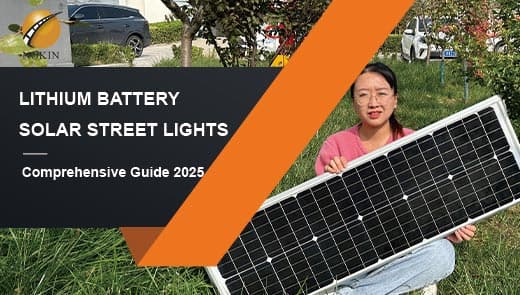LED Solar Street Lights-Lighting Solution for Rural Areas
In the vast rural areas, the installation and use of traditional lighting systems face many challenges, and the emergence of LED solar street lights has brought a new solution for rural lighting. It not only solves the problem of power supply in rural areas, but also shows great advantages in terms of economy, safety and sustainability.
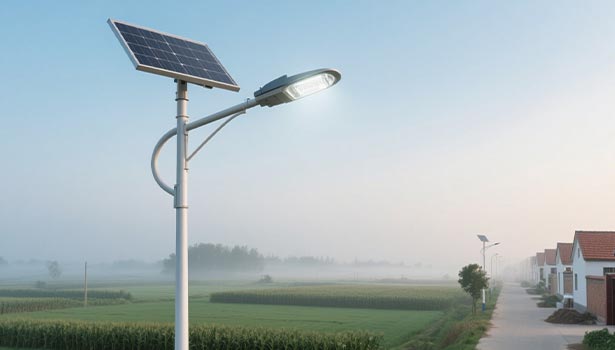
Why solar LED street lights are fantastic for rural areas
Solar panel lights skip on trench building for power
For rural residents and farmers, installing traditional lighting systems faces tricky For rural residents and farmers, installing traditional lighting systems can be tricky. Laying the wiring from the power source to the meter requires consideration of the length of the connection, the depth of the cable trench to be dug, and the cost of extensive labor excavation. Depending on the complexity of the infrastructure, the construction cost of the cable trench alone can easily reach thousands of dollars. And, in some areas with complex terrain or special environments, cable trenches can't even be built.
Solar LED street lights, on the other hand, do not need to rely on external grid power, which is certainly the best choice for rural areas with limited economic conditions. Compared with traditional electric lighting systems, solar streetlights cost much less in terms of installation, wiring and maintenance, and in the long run, their cost-effective advantages are significant. Below is a table comparing the costs of the two.
|
Item |
Traditional Electric Lighting System |
Solar LED Street Light |
|
Cable Trench Construction Cost |
Thousands of USD (varies by infrastructure complexity) |
None |
|
Long-Term Power Consumption Cost |
Continuous and high |
Almost none |
|
Maintenance Cost |
High, requires regular line inspections |
Low, only minimal maintenance needed |
Save money long-term by using solar
Energy prices have always been a concern in rural areas, especially where energy supplies are inadequate. According to a recent report by EEFA (Energy Efficiency for All), rural households spend more on energy than the average household. Therefore, it is urgent to implement energy saving measures in rural areas, and the use of solar-powered LED street lights is one of the most effective ways to reduce energy costs.
Solar LED street lights can significantly reduce a household's energy costs, saving a family more than $1,000 a year in electricity bills. Solar panels generate 15 watts of electricity per square foot of direct sunlight per hour. On average, solar panels receive 4 hours of direct sunlight per day. The savings from solar powered LED streetlights accumulate over time.
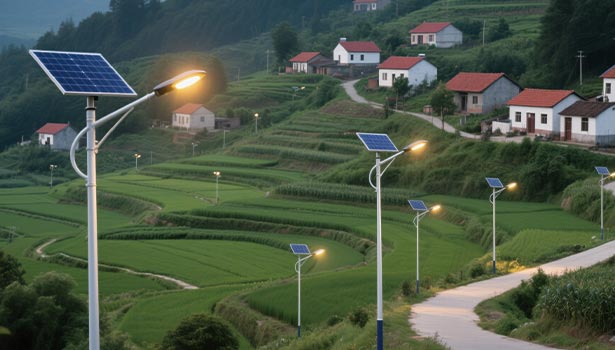
Safety and life quality on the rise with solar LED lighting
Violent crime rates in rural areas have risen over the past few decades. Rural communities have suffered from a lack of employment opportunities and downsizing of farms, which has led to increased crime. In addition, the opioid crisis has affected some rural communities. Therefore, it is critical to support rural areas in a variety of ways, with lighting improvements being one important aspect. Ensuring that rural communities have good lighting is an effective means of improving safety. According to a study published by LEDs Magazine, communities that participated in public lighting programs experienced a 39 percent drop in crime after installing new lighting systems. Good lighting also extends outdoor recreation time for family and friends, improving the quality of life for rural residents.
How solar street lights work?
Solar street lights rely primarily on photovoltaic panels to do their work. Photovoltaic panels absorb sunlight during the day and convert it into electricity, which is stored in solar cells. At night, the electricity stored in the batteries is used to light the LED streetlights, providing consistent and efficient lighting. The solar street light system consists of solar panels, storage batteries and charge controllers, and these components work perfectly with the LED lights to provide reliable lighting in rural areas.
Since solar streetlights are not dependent on the power grid, they can be used in remote areas with limited or no power supply at all. The system is rugged, suitable for virtually all environmental conditions and requires minimal maintenance, making it an ideal lighting solution for hard-to-reach rural communities.
What factors should be considered when installing rural solar street lights?
The place where solar street lights are installed should avoid having too many obstructions
When installing solar street lights, try to avoid having too many obstructions around them, such as foliage, buildings, etc. These obstructions can block sunlight. These obstructions will block the sunlight, affecting the absorption and utilization of solar energy and reducing the charging efficiency of the solar panels. If the solar panel is installed underneath a wire, tree branch, light pole, or other shade, it will leave a shadow on the panel during the day. Since the battery cells of a solar panel are usually connected in multiple strings, if there is a shadow on a particular string of battery cells and the shadow is deep, the string is equivalent to a circuit break in severe cases. If the solar panel is connected in parallel, the panel will not be able to generate electricity.
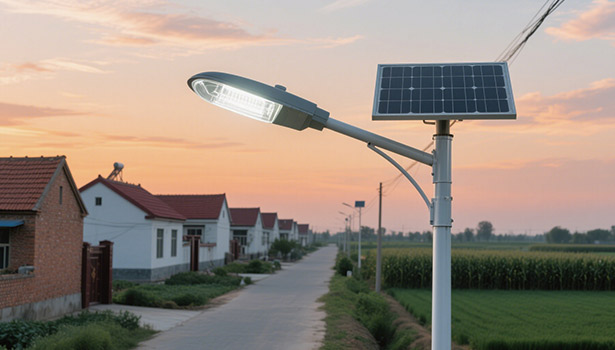
Do not install solar street lights in a bilaterally symmetrical manner
Solar street lights should be installed in a bilaterally symmetrical manner should be avoided. Some users may install solar panels in a bilaterally symmetrical manner for aesthetic reasons, but this will result in one side of the panel not receiving the sunlight correctly, thus reducing the charging efficiency. If one side is installed in the right direction, then the other side is bound to be wrong. The charging efficiency of the wrongly installed side will be greatly reduced because it cannot receive direct sunlight.
For example, in a village road reconstruction, for the pursuit of neat and beautiful double side symmetrical installation, the results after half a year, the wrong side of the installation of street lamps in the continuous cloudy and rainy days, the length of time than the correct side of the installation of street lamps less than an average of 2 - 3 hours. Professional testing shows that the wrong installation side panels due to insufficient light, power generation is reduced by about 40% compared with normal installation, seriously affecting the use of street lights and service life, which fully demonstrates the need for scientific installation.
The installation distance of solar street lights should not be too large
The installation distance of rural solar LED street lights is determined by the lighting power of the street lights, the height of the street lights and the width of the road and other factors, the common installation distance is between 25 and 50 meters. Generally, the common installation spacing is between 25 and 50 meters. However, some villages will determine the number of streetlights according to the budget when installing streetlights, and even increase the spacing of streetlights to save budget. However, the solar street light manufacturer reminds that the street light spacing is too large, which will seriously affect the lighting brightness and can't achieve a good lighting effect.
Avoid the presence of interfering light sources nearby
In addition, the presence of reference light sources near solar panels should be avoided. If there are other light sources near the solar panel, it may cause the charging voltage of the panel to be higher than the light-control voltage point, which will prevent the street light from turning on normally. For example, when there are other street lights next to the solar induction street light, when the night comes, the nearby street light is on, the solar panel of the village solar street light detects the light source, and will mistakenly think that it is daytime, and at this time the controller will not let the street light come on.
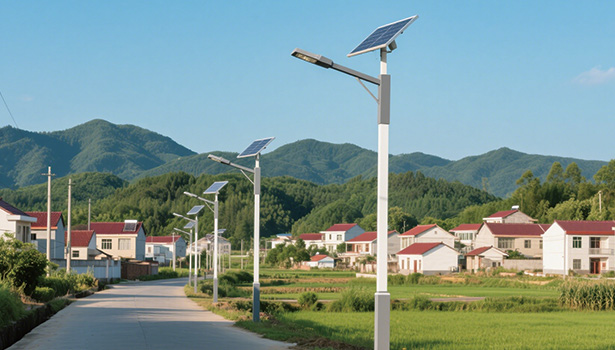
Rural solar street lights maintenance method
Regular cleaning
It is vital to do a good job of maintaining rural solar street lights and cleaning them regularly. Rural solar street lights are mainly used for outdoor products, in the process of long-term use, sand, dust, bird droppings, leaves and other dirt will continue to accumulate on the solar panel and the surface of the lamp. If you do not clean up these stains in time, it will seriously affect the lighting effect of the product, because the dirt on the surface of the solar panel will reduce the photoelectric conversion efficiency, and when the situation is serious, it will even shorten the service life of the product, so the cleaning work is very important and necessary.
Clean rural street light products, you can use tap water rinse, this cleaning method is very effective. However, the cleaning needs to follow a certain method, in general, must pay attention to the top-down water rinse, avoid bottom-up cleaning, which is very critical. If you do not follow a specific direction of cleaning, the sewage will flow into the interior of the lamps and lanterns along the seams, which may cause problems such as short circuit, and the cleaning effect will also be greatly reduced.
Main points for regular inspection and maintenance
In the maintenance of rural solar street lamps, in addition to cleaning work, regular overhaul maintenance is also a good way to maintain. Every quarter, you should check whether the connection of the various components of the street light is stable, and see whether the angle of the solar panel is shifted due to external forces, whether the battery power is normal, and whether there are flickering LED lights and other faults. Preventive maintenance can find out whether there are problems with the product in time, in order to deal with them accordingly, so that the product can play a better role.
LED solar street light in rural areas has unparalleled comprehensive advantages. It not only solves the problem of power supply and lighting in rural areas, but also plays an important role in saving costs, improving safety, promoting economic development and educational progress. With the continuous progress and popularization of technology, LED solar street lights will be more widely used in rural areas, providing a strong boost for the development and prosperity of rural areas, and illuminating the bright future of rural areas.

